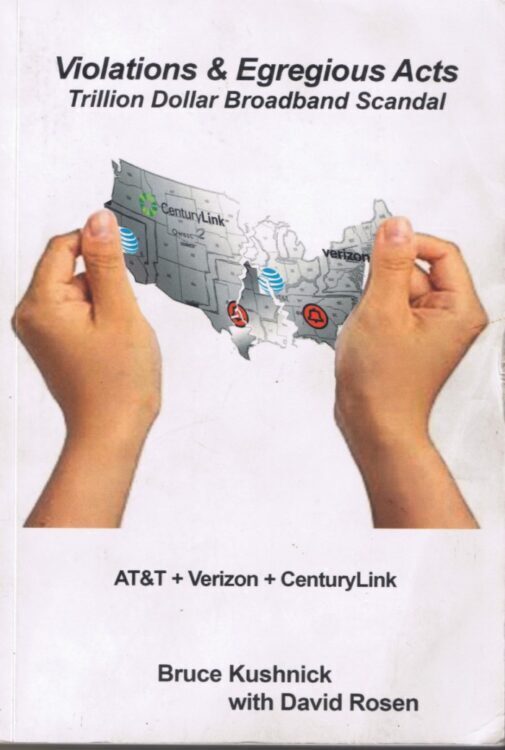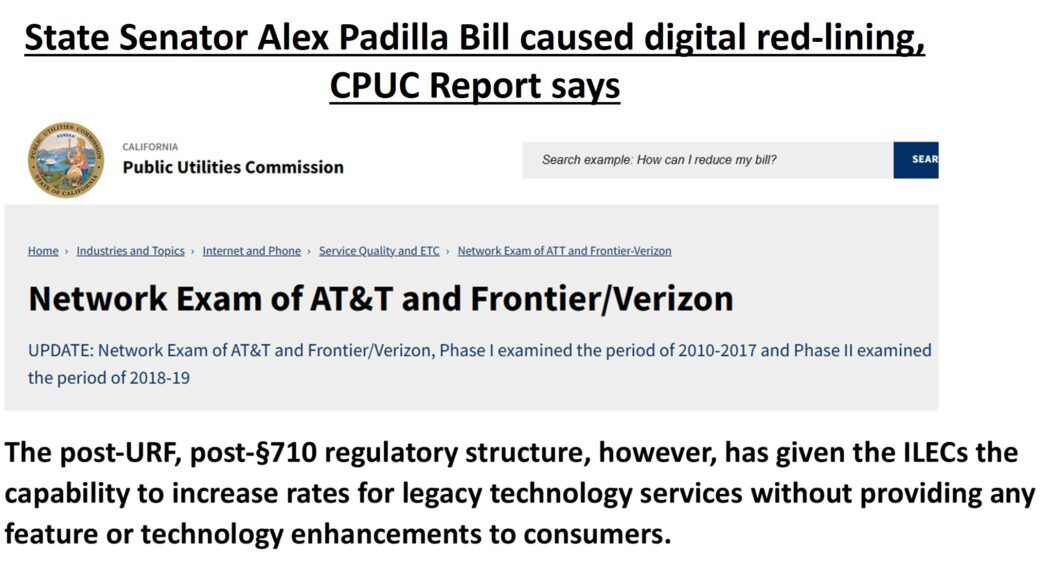
The 4th Iteration of ‘Bait and Switch’: Fraud? Regulatory Corruption? and the Digital Divide!
According to Technology Analyst and Author Bruce Kushnick, over $500 BILLION has been given to Telcos (state telecommunication utility companies, a.k.a. Verizon, AT&T, Century Link, et al) for fiber-optic upgrades to the premises (FTTP) – which was never delivered.
Ana Montes, retired 30-year technology expert from the bay area says, “It’s documented,” that the Telcos were given money to upgrade the networks with fiber-optics, but did not deliver. Watch the full interview here: Tech Talks featuring Ana Montes.
June 5, 2023:
By Larry Ortega
Planned deployments of fiber-to-the-premises (FTTP) under U-verse (AT&T) and FiOS (Verizon, now Frontier) were halted – on or about 2010 – when AT&T’s and then Verizon’s CEO’s decided wireless would serve as a substitute…would serve as a substitute…would serve as a substitute. Like in a made for TV horror film, you can hear the words substitute echoing in the deep dark halls of economic disaster. Over dramatic? Maybe. But surely no understatement for the 2 million kids in California that went nearly a year and half without attending school on a regular basis, due to the digital red-lining exacted on them by the state’s telecommunication utility. The “illegitimate” cash register rung loud for the AT&T’s and Verizon’s of California! From my purview, the only thing that could have made it better for these giant telecommunication behemoths would have been if they had their own money printing machines in their garages. In an unregulated, highly profitable, slush-fund-maximizing, corruption-institutionalizing, all-around f*ckery of a regime in California’s telecommunication industry – the casualties would be limited to children, integrity and the poor, says Author Bruce Kushnick in his newly published book:![]()
![]() Violations and Egregious Acts, Trillion Dollar Broadband Scandal.
Violations and Egregious Acts, Trillion Dollar Broadband Scandal.
The Great Substitution: A state telecommunication utility strategy to take rate payer money designated for fiber-optic build-out and…run! In a giant coordinated fervor to facilitate the Great Substitution, perpetrators (perps), with the grace and execution of an Olympic Synchronized Swimming team, locked-in the United States’ 28th position, behind 27 other developed countries – in fiber-optic deployment. Meet the Perps:
Perp #1:
Former Verizon Attorney Brandon Carr, through the turnstile of the revolving door and as Federal Communications Commissioner – Carr (Brandon) – set a ‘shot-clock’ order from the ivory tower of the Federal Communications Commission (FCC) for 5G deployment. An impossible and impractical mandate by the federal government to usurp local municipalities authority over safety and placement of cell towers/antennas. A technology (5G) – by the way – that literally had nothing to do with making the US more competitive. How could it? According to Ernesto Falcon of the Electronic Frontier Foundation: wireless (5G) is 10,000 times slower than fiber optics. Brandon’s order had little to do with competitiveness and everything to do with the Great Substitution – a ‘bait and switch’ game now in its 4th iteration.
Perp #2
In 2012 State Senator Alex Padilla introduced and fast-tracked SB1161, which was codified into California PU710: allowing the state’s telecommunication utility to NOT upgrade (to fiber optics) the telecommunication infrastructure (FTTP), despite receiving rate increases and grants to do this very work;
Perp #3
The ALEC regime: A series of CA state legislator sponsored bills (most likely written by ALEC) begin to make their way through the CA state legislature – in the name of making US more competitive and closing the digital divide – both contentions are blatantly false in my professional opinion:
- SB649 in 2018: ALEC designed bill would allow the unpermitted, no notice – mass proliferation of wireless infrastructure on public rights of ways; passed the Assembly and the State Senate – VETOED by Governor Brown;
- SB556 in 2021: same ALEC designed bill – that again – would allow the unpermitted, no notice – mass proliferation of wireless infrastructure on public rights of ways; passed the Assembly and the State Senate – VETOED by Governor Newsom;
- AB537 also in 2021 and twin sister to SB556 from above, essentially accomplishes what SB556 sought; ALEC members would appear to have found a new strategy in running “twins” down CA’s legislative channel with hopes of one making it; FCC Commissioner Carr, ALEC and friends net the win, Governor Newsom signs AB537;
Perp #4
In October of 2022 the Los Angeles County Board of Supervisors unanimously pass Los Angeles County Title 16 and 22 Ordinance Modifications; outcomes of these ordinance modifications effectively exact non-permitted, no notice proliferation of wireless antennas and towers, donning similar language to 2 previously vetoed bills, by 2 separate CA Governors.
Under a cloud of bamboozled-ism, the Los Angeles County Board of Supervisors believed such wireless proliferation would serve to expedite the closing of the digital divide; not realizing such an ordinance marries previously digitally red-lined communities to inferior, more costly, technology. Absolutely not their fault, as they are doing the best they can with the options they have been told are at their disposal. No one to blame here except the Telcos and their lobbyist; who I imagine made more promises, and of course shared none of the details on their past malfeasance regarding this subject.
Lacking Leadership at the Helm of the
95% OF ELECTED AND APPOINTED OFFICIALS: UNAWARE
“Broadband forAll[Some]” Initiative:
Call for Immediate Structured Training at all Levels,
Elected, Appointed, Community and School Leadership
California’s leadership on current broadband planning strategies, specifically the Broadband for All, Digital Equity, and BEAD Planning Workshops, lacked in composition and stated targeted metrics. Phraseology such as “we must get our fair share” appeared to lead to the all-out abandonment of logic, history, community technology expertise and ultimately a solid pathway forward to closing the digital divide – in particular to previously digitally red-lined communities.
Contrary to successful models in Pharr Texas, Chattanooga Tennessee, and Medina Ohio, a majority of municipalities in California are destined to be relegated to the lowest rung on the technology ladder given current standards – set by lobbyist in the ears of our legislators; speed tests that are essentially and practically irrelevant when looking at the prize, the true prize of US competitiveness which requires it to move-up into the top ten of the ratings chart on fiber-optic deployment (FTTP), at the very least.
Celebrating broadband infrastructure that nets 100/10mpbs is akin to celebrating the upgrade from a 1970 Volkswagen Bug to a 2002 Honda Civic…Yippie!
Fiber Broadband Association President Gary Bolton told me that a standard of 500mbps – symmetrical – is the true measuring stick for the next 2 years, with 1gig bps(bits per second) to follow shortly thereafter.
Of course California, to some outside the smokescreen of deception we find ourselves in, is the laughingstock of this telecommunication infrastructure upgrade initiative; mere children playing in the sandbox of telecommunication infrastructure with wireless-legos, while the rest of the country and globe are Fibering-Up their Neighborhoods – with fiber-optic infrastructure in the name of true and sensible competitiveness.
Broadband for All? Sure, when you dilute the meaning of high-speed connectivity to the Internet’s resources, given the current leadership and irrelevant metrics being inserted into the conversation. Otherwise and more appropriately, California’s initiative should be titled Broadband for Some – leaving students currently sitting in the parking lot of Taco Bell to gain access to WiFi signals, now being at home for the near-same sucky-service…waiting, waiting…waiting.
California notwithstanding, economic engines around the country will be running at a minimum of 500/500mbps, and seeing standards of 1gig up and down as normal as the lights going on when we flip the on-switch in our dining rooms.
First and foremost we must shake-up the leadership of CA’s current Broadband for Some initiative. Second, we must remove the cataracts of ignorance from our state and municipal elected officials on what broadband is, truly; and the economic imperative relating to FTTP. Third, we must go full-throttle on engaging our youth into the mission of creating on-line messaging as to what this huge economic injection (FTTP) means to every man, woman and child.
There is a group of tech leaders who have said: Ya Basta! Enough is enough! Let’s roll-up our sleeves and get this thing done. Beginning with training and in-language promotion, we offer the following start points and ask that they be incorporated into the conversation relating to the planning phases of CA’s fiber-build endeavor.
- There is approximately $1.5 billion and $6.5 billion from federal and state sources, respectively, to deploy fiber in California; even after these government investments, California is forecasted to fall well short of what is needed to close the digital divide;
- There are significant quality of service differences between wireless and fiber optics;
- Price of Internet service is the number one barrier to families getting Internet service at home; lowering price of service must be incorporated as a top desired objective;
- There is a court case that frees the state of California from federal mandates on setting Internet pricing and allows for fair pricing audits and investigations;
- Mounting evidence that the subsidy offered through the Affordable Connectivity Program (ACP) is set to end by December 2024;
- There is documented evidence that pricing has not went down as a result of massive mega-mergers;
- There is documented evidence telcos (state’s utility on telecommunication services) failed to upgrade network with fiber optics, despite being given billions of dollars in rate increases and grants to upgrade the networks;
- Measuring metrics currently in place for measuring speed serves to dilute primary objective of fiber to the premises (FTTP) deployment; we must work to eliminate speed standards and metrics and commit to fiber deployment;
- There is a major gap in expertise on community technology programming at the helm of the State’s fiber-optic deployment planners;
- Establish Wikipedia-like “community technology” on-line facts page;
- Establish Career-Tech Education, project-based learning for high school and community college students around closing the digital divide;
- Official engagement of the philanthropic community and non-governmental investment entities to shore-up expected investment short-fall in fiber deployment;
- Institute Audits and Investigations into the money given state telecommunication utilities; asking has the product (FTTP) been delivered? If not, what are the consequences – with “doing nothing” not being an allowable option;
- Clear Definition of Broadband meaning: connectivity via fiber-optics; and not diluted with references to DSL (copper), cable or wireless substitutes;
- Recognition of probable biological harms to small children, pets and plant life from excessive RF (radio frequency) waves from wireless devices and infrastructure such as fixed wireless solutions, according to over 1,000 independent studies;
- In-language promotion and communication of all stated facts and plans, using alternative media such as Black, Chinese and Latino newspaper and media agencies.
A meeting with California’s Majority Leader for the Assembly has been set for June 7th. We are calling on all interested parties to provide input prior to this meeting, as it relates to our call for formal and systemic training to state, municipal and community leaders on the meaning and necessity of a fiber-optic infrastructure build, FTTP.
UPDATED: September 28, 2023: Meeting with Majority Leader Emeritus fell well short of our expectations. The biggest challenge we had on June 7th was the time she gave us which was cut to just 20 minutes – for a topic so crucial to California’s future – no way we get any traction in that amount of time. I subsequently wrote an email to the Majority Leader Emeritus asking for another meeting. When she first ran for the Assembly she held that her opponent, then Assemblymember Cheryl Brown was a mere shill of big oil companies, and we supported her because Assemblymember Gomez Reyes would bring change, independence from corporate interests…that seems to have waned a little regarding the telecommunication’s interests. I asked how do we begin the process of educating our California legislators – through the dominating messaging of corporate interests? We hope to hear back.
Share this article and video link with everyone you know. The story must make its way out of the abyss of “nothing to see here.” Plenty to see, just listen and watch Ana Montes here in this video link: Tech Talks with Ana Montes 6 .1.23: Scathing indictment on players responsible for digital divide.
Larry Ortega
June 5, 2023
